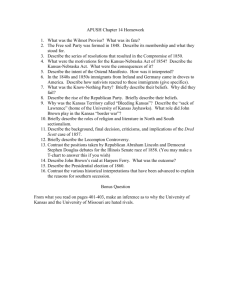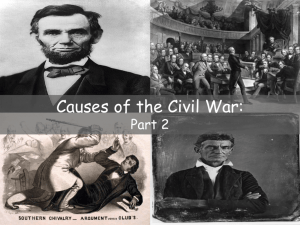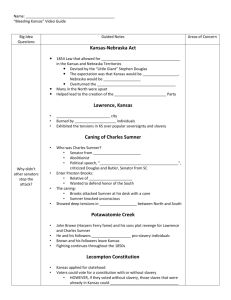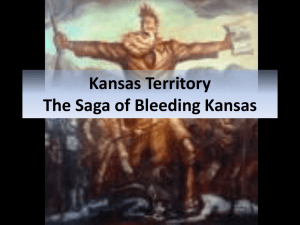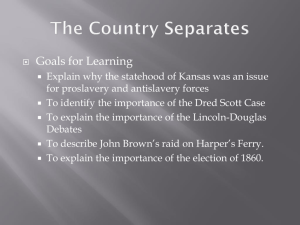Kansas-Nebraska Act
advertisement
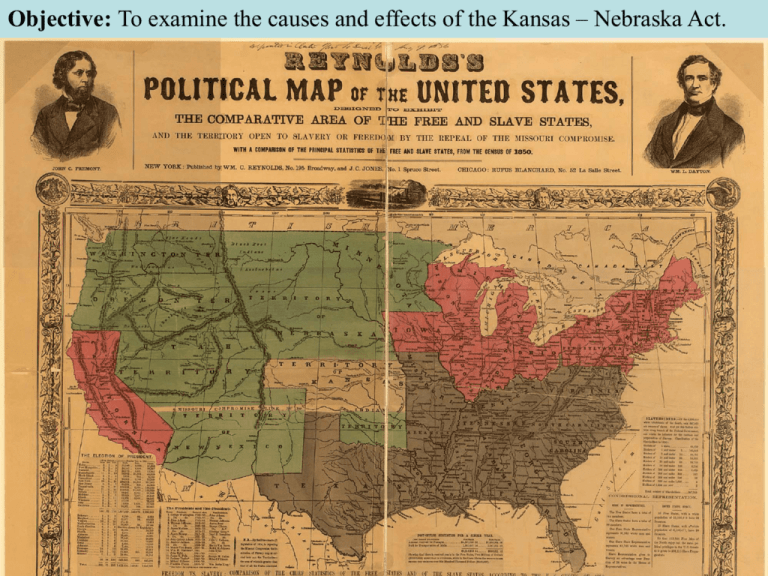
Objective: To examine the causes and effects of the Kansas – Nebraska Act. Kansas-Nebraska Act I. The Nebraska Territory was divided into two parts: Nebraska (NE) and Kansas (KS). Kansas-Nebraska Act II. The people of each territory voted on whether or not to allow slavery. (popular sovereignty) * The Kansas-Nebraska Act violated the Missouri Compromise. Both territories were north of 36 , 30’ N and should NOT have been allowed to have slaves. “Bleeding Kansas” Before the vote on slavery: • Northerners crossed the border to keep KS a free state. • Southerners crossed the border to make KS a slave state. • Both sides claimed victory on the vote! On May 19, 1856, Senator Charles Sumner, a Massachusetts antislavery Republican, addressed the Senate on the… …explosive issue of whether Kansas should be admitted to the Union as a slave state or a free state. In his speech, Sumner identified two Democratic senators as the principal culprits in this crime—Stephen Douglas of Illinois and Andrew Butler of South Carolina. He characterized Douglas to his face as a "noise-some, squat, and nameless animal . . . not a proper model for an American senator.” Sumner continued by mocking Senator Butler’s stance as a man of chivalry, charging him with taking "a mistress . . . who, though ugly to others, is always lovely to him; though polluted in the sight of the world, is chaste in his sight—I mean” added Sumner, "the harlot, Slavery.” Representative Preston Brooks, Butler's South Carolina kinsman, entered the Senate three days later and slammed his metal-topped cane onto the unsuspecting Sumner's head leaving him bloody and unconscious. George S. Park, the founder of Parkville, Missouri, and owner of the Parkville Luminary newspaper, dared to speak out against the actions of the "Border Ruffians." As a result, they took revenge by breaking into the newspaper office and throwing the printing press into the nearby Missouri River. Territorial Governor Andrew Reeder fled the territory disguised as a woodcutter because the proslavery Border Ruffians threatened to hang him. Pearl-handled sword of Col. Henry Theodore Titus, leader of pro-slavery forces during “Bleeding Kansas”. * In 1856, an abolitionist named John Brown murdered five proslavery men. * Over 200 people died in the fighting that followed. The abolitionist John Brown lived in Osawatomie, Kansas Territory. Brown and his sons were responsible for the brutal murder of several proslavery men near Pottawatomie, Kansas. The men were called out of their homes at night and hacked to death with swords. This was just one of many incidents that earned Kansas Territory the name of "Bleeding Kansas.” Marais de Cygne Massacre “Bleeding Kansas” Video (4:02) In May 1858, proslavery settlers executed a group of their free state neighbors along the Marais de Cygne river in southeastern Kansas Territory.




